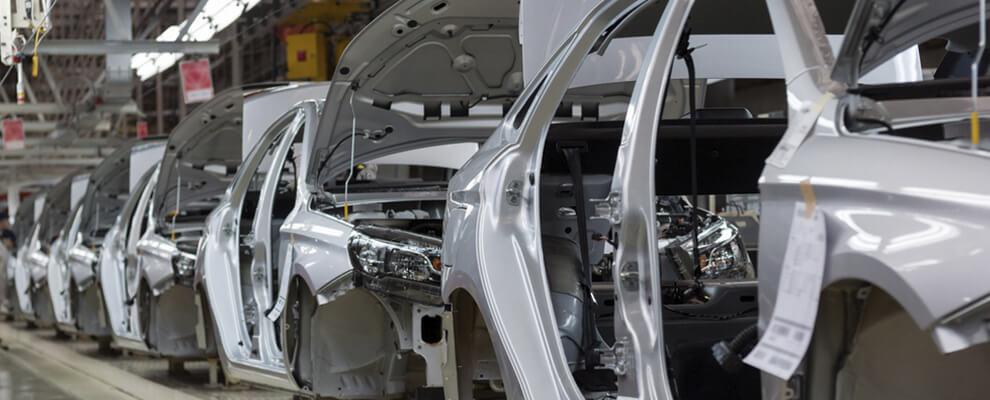The automotive industry has always been at the vanguard of industrial innovation. Auto manufacturing first adopted the assembly line and later became the first industry to embrace automation with robotics. Auto manufacturers continue to press forward to look for ways to implement automation. Today, even suppliers need to evaluate how they can automate processes to remain competitive. Consider the latest trends in robotics in the auto industry and which tools you can adopt now to stay ahead of your competition.

Transforming Automotive Manufacturing with Robotics and Automation
Robotic Systems in Auto Manufacturing Continue to Grow
Across the entire auto industry, more than one million robotic systems are in operation. Robotics are no longer limited to final assembly operations; suppliers and smaller manufacturers are using them, too. Robotic systems produce better quality components at a faster rate than even the most affordable labor can, which means that to secure contracts, you need automation to add value to your production.
Although most companies have already put robots to use for basic assembly and welding tasks, there are several upgrades available now to improve the efficiency of existing robotic systems. In addition, new forms of robotics are available that can automate other tasks. If you’re not sure how to best optimize your workflow with robotics, reach out to an experienced technology advisor.
Enhancing Existing Robotic Systems
How can you make your existing robotics more efficient and productive? The most effective way is to minimize downtime as much as possible. When one machine fails, the entire production line has to stop. In order to keep your robots running well, you need to perform maintenance intelligently. Rather than routinely servicing machines on a schedule, you can use machine data to perform proactive maintenance.
Over time, you’ll gather information that can lead to accurate predictions, allowing you to service your equipment conveniently before it starts to operate out of spec. Beyond preventative maintenance, there are also upgrades that can help you automate troubleshooting and QC in real time.
Analyzing Data from Robotics
Robots are already digital, which makes data capture extremely simple. However, many SMEs in auto manufacturing program their equipment and fail to take the next step. Using IoT data hubs, it’s possible to capture all of the data your machines output while they work. This data can then be relayed to a central server for processing. Alternatively, you can upload the data into cloud storage and use cloud computing to avoid spending heavily on a local server.
With data analytics software running in the cloud, you can even configure live dashboards that give you real-time performance data. As you analyze this data, you can spot machines that are starting to fail and take proactive action to keep them running.
Barcode Reading for Traceability and Quality Control
Barcodes add a layer of control to your entire operation. Raw materials and source components can be tagged with barcodes that your robots scan as they pass through the production line.
Not only can you use these barcodes to signal to other machines when to start their programmed operations, which can shave valuable seconds between tasks, but you can also track production and avoid errors. For instance, if a robot reads the wrong barcode or cannot read one, the production line can automatically notify an engineer to inspect the component. If problems are discovered after shipping, you can trace the origin of all your source materials to facilitate troubleshooting.
The Latest Robotics for Automotive Manufacturing
Besides the aforementioned upgrades that bolster the performance of existing robotics, there are several new tools that you may want to consider adding to your operations. You can automate more tasks with the help of these new robotics systems, thereby increasing your overall productivity.
Automated Vehicles
Automated vehicles have become much more capable of navigating complex factory environments. The simplest are guided vehicles, which depend on markings on the floor to dictate their movements. More advanced autonomous vehicles can use cameras and image processing to navigate independently.
These vehicles can automate the movement of source materials and finished products to other locations. By synchronizing these machines with other data sources, you can ensure that your production line keeps running without the need for workers to manually load and unload.
Collaborative Robots Complement Human Tasks
Also known as Cobots, collaborative robots are designed to work alongside humans. They feature safeguards to protect human workers, including proximity sensors and rounded edges to avoid injuries. These robots can take over hazardous tasks such as spray-painting, which would otherwise expose workers to harmful aerosols.
Cobots can be used to inspect human handiwork or handle finer tasks that require precision beyond what fingers are capable of. Adding them to your line is a great way to improve operations or transition to further automation in the future.
Automated Test Equipment
Testing your components is vital. Quality control and consistency is what secures long-term contracts and repeat business. However, running tests takes significant time away from your team. With automated test equipment, you can queue up a sequence of tests and walk away. Data can be saved or streamed to a data analytics system so that you receive results as soon as they are available. Most importantly, automated testing removes human error from the equation, which makes your testing more reliable.
If you want your auto manufacturing company to remain competitive and secure more lucrative contracts going forward, automation is the only answer. By working with an experienced technology solutions provider, you can get a personalized plan to upgrade your operations. Contact SAAB RDS to learn more about our automotive industry solutions.
